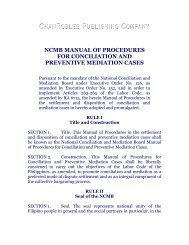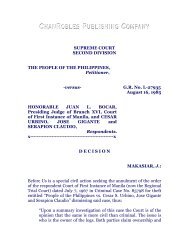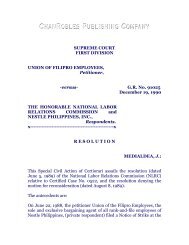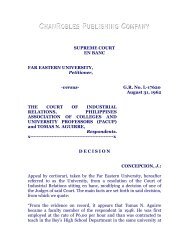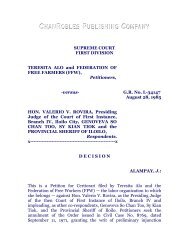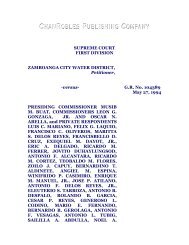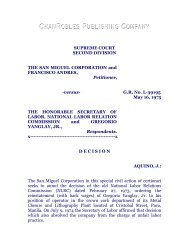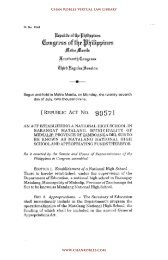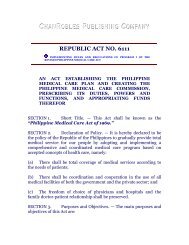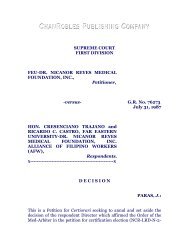SUPREME COURT SECOND DIVISION JOSELITO LAGERA ...
SUPREME COURT SECOND DIVISION JOSELITO LAGERA ...
SUPREME COURT SECOND DIVISION JOSELITO LAGERA ...
You also want an ePaper? Increase the reach of your titles
YUMPU automatically turns print PDFs into web optimized ePapers that Google loves.
<strong>JOSELITO</strong> <strong>LAGERA</strong>,<br />
Petitioner,<br />
<strong>SUPREME</strong> <strong>COURT</strong><br />
<strong>SECOND</strong> <strong>DIVISION</strong><br />
-versus- G.R. No. 123636<br />
March 31, 2000<br />
NATIONAL LABOR RELATIONS<br />
COMMISSION (NLRC) and<br />
PHILIPPINE NATIONAL<br />
CONSTRUCTION CORPORATION,<br />
Respondents.<br />
x----------------------------------------------------x<br />
R E S O L U T I O N<br />
QUISUMBING, J.:<br />
This Petition for Certiorari seeks to annul the Decision of NLRC<br />
promulgated on October 18, 1995, in NLRC RB-IV-5-6683-94-C,<br />
which reversed the Labor Arbiter’s finding that private respondent is<br />
guilty of illegal dismissal. chanroblespublishingcompany<br />
Petitioner was hired as security guard by private respondent on<br />
December 30, 1993. His employment was covered by a contract<br />
renewable monthly based upon his “passing the company standard.”
On April 13, 1994, about 1:00 o’clock in the afternoon, the vehicle of<br />
private respondent carrying petitioner and four other security guards<br />
on board, swerved and crashed against a fence of the South Luzon<br />
Tollways in Bicutan, Taguig, Metro Manila, causing the passengers on<br />
board to suffer physical injuries. That same afternoon, private<br />
respondent’s security officer conducted an investigation of the<br />
incident. All the guards involved including petitioner were summoned<br />
to give their story of the accident. Petitioner, however, refused to<br />
report anything he knew as he “will first think over the matter”<br />
(Pagiisipan ko). chanroblespublishingcompany<br />
After three days, petitioner was again summoned to shed light on the<br />
accident, but still he refused to cooperate as, according to him, he was<br />
not yet in his proper mind to do so (Naguguluhan ako). chanroblespublishingcompany<br />
On this score, the security officer gave petitioner a chance to explain<br />
why his employment should still be renewed despite his actuations, to<br />
which petitioner only replied, “No comment ako diyan, sir.” This<br />
prompted the security officer to recommend the non-renewal of<br />
petitioner’s employment on the ground of failure to meet company<br />
standards. Petitioner was separated from the service effective May 1,<br />
1994. chanroblespublishingcompany<br />
Aggrieved, petitioner filed before the Arbitration Branch of the NLRC,<br />
a complaint for illegal dismissal and non-payment of salary against<br />
private respondent.<br />
On November 28, 1994, the Labor Arbiter handed down a decision<br />
finding private respondent guilty of illegal dismissal, the decretal<br />
portion of which states: chanroblespublishingcompany<br />
“WHEREFORE, in the light of the foregoing, judgment is<br />
hereby rendered, finding respondent PNCC guilty of illegal<br />
dismissal ordering said respondent to reinstate complainant to<br />
his former position Security Guard without loss of seniority<br />
rights and with full backwages from the time he was deprived of<br />
his salary on April 30, 1994 up to November 30, 1994 and<br />
unpaid salary and 13th month pay in the total amount of<br />
P26,460.00. chanroblespublishingcompany
At the option of the respondent, pending appeal, to reinstate<br />
complainant physically or merely in the payroll. chanroblespublishingcompany<br />
SO ORDERED”. [1]<br />
On appeal, respondent NLRC set aside the decision of the Labor<br />
Arbiter and declared the dismissal of petitioner as valid. It however<br />
noted that private respondent did not observe due process in<br />
terminating the employment of petitioner. Public respondent<br />
disposed of the case as follows: chanroblespublishingcompany<br />
“WHEREFORE, premises considered, the decision declaring<br />
that complainant was illegally dismissed is hereby ordered set<br />
aside and a new one is hereby rendered declaring said dismissal<br />
valid. However, respondent is ordered to indemnify<br />
complainant in the amount of P1,000.00.<br />
The decision holding that complainant is entitled to his unpaid<br />
wages from April 16-30 and proportionate 13th month pay for<br />
1994 is Affirmed. chanroblespublishingcompany<br />
SO ORDERED.” [2]<br />
Petitioner received a copy of the assailed decision on November 27,<br />
1995. [3] Unfortunately, petitioner did not file a motion for<br />
reconsideration. Instead, he went straight to this Court through this<br />
special civil action for certiorari imputing grave abuse of discretion on<br />
the part of public respondent in reversing the decision of the labor<br />
arbiter. chanroblespublishingcompany<br />
The precipitate filing of this special civil action for certiorari without<br />
first moving for reconsideration of the assailed judgment of NLRC<br />
warrants the outright dismissal of this case. As we consistently held in<br />
numerous cases, [4] a motion for reconsideration is indispensable for it<br />
affords the NLRC an opportunity to rectify errors or mistakes it might<br />
have committed before resort to the courts can be had. chanroblespublishingcompany<br />
It is settled that certiorari will lie only if there is no appeal or any<br />
other plain, speedy and adequate remedy in the ordinary course of<br />
law against acts of public respondent. [5] In the case at bar, the plain
and adequate remedy expressly provided by law was a motion for<br />
reconsideration of the impugned decision, based on palpable or<br />
patent errors, to be made under oath and filed within ten (10) days<br />
from receipt of the questioned judgment of the NLRC, a procedure<br />
which is jurisdictional. Hence, original action of certiorari, as in this<br />
case will not prosper. chanroblespublishingcompany<br />
Further, not having filed a motion for reconsideration within the tenday<br />
reglementary period, the questioned order, resolution or decision<br />
of NLRC, becomes final and executory after ten (10) calendar days<br />
from receipt thereof. Thus, as regards petitioner, the decision of<br />
NLRC became final and executory on December 7, 1995.<br />
Consequently, the merits of the case can no longer be reviewed to<br />
determine if the respondent NLRC could be faulted of grave abuse of<br />
discretion. chanroblespublishingcompany<br />
WHEREFORE, the instant petition is DISMISSED, and the<br />
assailed DECISION of public respondent is AFFIRMED. chanroblespublishingcompany<br />
SO ORDERED.<br />
Bellosillo, Mendoza, Buena and De Leon, Jr., JJ., concur.<br />
chanroblespublishingcompany<br />
[1] Rollo, p. 46.<br />
[2] Rollo, pp. 67-68.<br />
[3] Rollo, p. 3. chanroblespublishingcompany<br />
[4] Escorpizo vs. University of Baguio, et al., GR-121962, April 30, 1999, p. 3;<br />
Manila Midtown Hotels & Land Corp. vs. NLRC, 288 SCRA 259, 264 (1998);<br />
ABS-CBN Employees Union vs. NLRC, 276 SCRA 123, 129 (1997); Gonpu<br />
Services Corporation vs. NLRC, 266 SCRA 657, 660 (1997). chanroblespublishingcompany<br />
[5] Building Care Corporation vs. NLRC, 268 SCRA 666, 674 (1997); Inter-orient<br />
Maritime Enterprises Inc. vs. NLRC, 261 SCRA 757, 764-765 (1996).


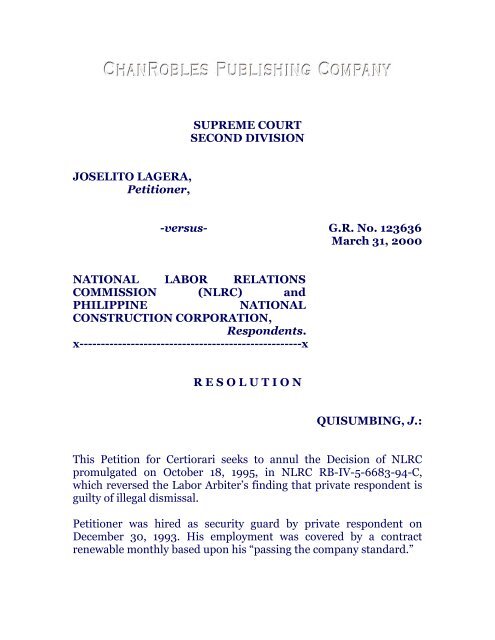
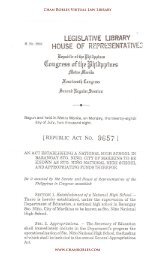
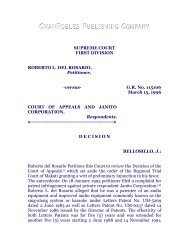
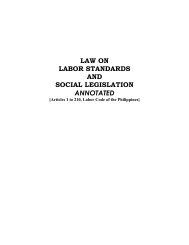
![Aurelio vs. NLRC, (221 SCRA 432 [1993]) - Chan Robles and ...](https://img.yumpu.com/51280528/1/190x245/aurelio-vs-nlrc-221-scra-432-1993-chan-robles-and-.jpg?quality=85)
